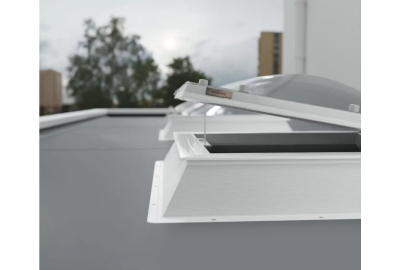Coxdome FAQ - a short guide
Coxdome FAQ
A rooflight can be a magnificent way of opening up your home, allowing fresh air and natural light into any living space, brightening up darker areas or exposing well-used rooms to the sun.
But it can also be a big investment, and it’s important to get a little more information before you begin. So, we’ve created an FAQ that will serve as an introduction to our Coxdome range.
What is a rooflight?
Simply, it’s a glazed unit that is typically fitted on a flat roof, or where installed on a pitched roof it is fitted in level with the tiling. The actual window is fitted onto a raised kerb or upstand, which supports the product and keeps it away from the roof surface.
What are the different designs of rooflights?
Currently, we stock four different types of Coxdome rooflights:
· Fixed dome, a dome that stays rigid on the kerb
· Manual dome, opened by a winding pole with a spindle gear
· Electric dome, operated by a wall mounted switch.
· Galaxy dome, a replacement dome for previous installations
These are all individually priced based on surface area of the dome and area installed, with the lowest price being the galaxy replacement, going up to the electric dome.
What is the skin size?
Basically, the thickness of the of the dome. A single skin will feature great exposure to natural light but thermal insulation is low in comparison to a triple skin; this skin gives great thermal insulation but the natural sunlight it lets in is low. We advise the double skin, which allows for a happy medium of both extremes.
What are the glazing choices?
These are the different tints of the dome. Clear polycarbonate is the clearest of the three, letting in maximum light but this will reduce the privacy available. Opal lets in less light, and will diffuse it better, which makes it ideal for rooms in which computers and books are used – this also makes it more private. Diffused is, as the name suggests, for diffusing the light from coming into the room, and offers great oritectuib frin tge
A few points to consider:
-If you’re unsure, ask! Once the roof has been cut, it can be an expensive and time-consuming job to restore if you change your mind or measure wrong. We would always advise having a professional look before you begin.
-If possible, come to a branch to see a sample for yourself. It’s hard to imagine what a product will look like installed simply from a picture; you get a much firmer idea from seeing it in person.
-Like any construction work, cost the entirety of the job from start-to-finish; ensure that the price paid will leave you with a usable and fully installed rooflight.
-While Coxdomes offer excellent energy efficiency and thermal performance, it’s important to make note of how good the insulation will be – this will be different for each installation so there isn’t just one set value for each product.
Glossary:
Diffusion: How the light spreads once it enters a room. A higher rate of light diffusion will spread the light much further around a roomthan a clear polycarbonate, which will spread it straight through the window
Glazing: The finish of the polycarbonate on top of the light.
Skin: Thickness of the polycarbonate on top of the light.
U-Value: The rate at which a window, door or skylight transmits non-solar heatflow. In short, this measures how much heat is lost; a lower number loses less heat.







